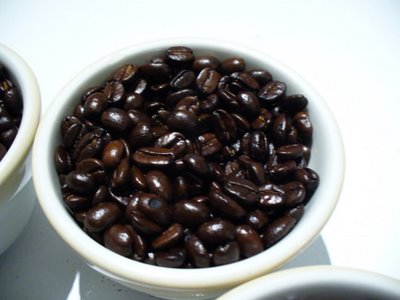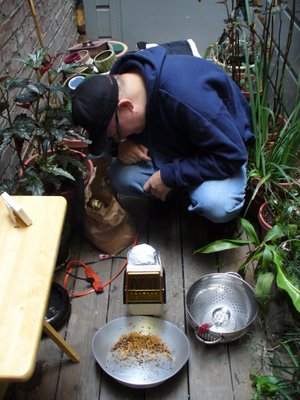The heating in the building I work in has been off all day today and I swear if it gets any colder our office plants are going into dormancy.
Speaking of, last weekend, Bruce, Bill, and I went to the Fall meeting of the Bay Area Carnivorous Plant Society, or
BACPS, at the Berkeley Botanical Garden (BBG). The BACPS's quarterly meetings alternate between the
Berkeley Botanical Garden meeting room and the
Randall Museum in San Francisco, and this was the first meeting I'd been to in at least 3 years.
While the Randall Museum is cool, and definitely a place you should check out, I love the Berkeley Botanical Garden! As a San Franciscan, I'm partial (of course) to the
Conservatory of Flowers and various gardens in Golden Gate Park. But while the Conservatory has that instant "wow" appeal, the BBG is a plant geek's paradise. The amount of species the BBG has on display is mind-boggling and very well presented in various sections of the garden.

The BBG has been the best place to see carnivorous plants, or "CP", in Northern California (other than
Peter's nursery) for many years. In fact, one of the caretakers of the garden, Judith Finn, has a
Nepenthes cultivar named after her, as she has done much to promote carnivorous plants both at the BBG and in the wider community of horticultural and botanical enthusiasts. How cool is that??!
The Conservatory of Flowers also has a small but decent display of CPs and word has it that they are ditching the lame "Butterfly Zone" and expanding their CP collection.
About time.
While Bruce and I still grow a large number of carnivorous plant species on our deck and inside in tanks underneath fluorescent lights, I no longer feel the overwhelming urge to be part of the "CP community". However, after watching Barry Rice speak about his
latest book and his field trips in Montana, Massachusetts, Idaho, and Texas, I could be persuaded to rejoin it.
Dr. Barry Rice is one of the coolest, funniest, people I've ever had the chance to see and meet. His incredible sense of humor makes sitting through a 3 hour slide presentation on fens, floating sphagnum mats, and bladderworts virtually painless and highly enjoyable.

In addition to being a well-respected botanist and Dim Sum connoisseur, Barry is a staunch defender of preserving wild habitats with a particular axe-to-grind for
invasive species, whether they be man, animal, or plant. In regards to dive restaurants, I also am a staunch defender of wild habitats (
Taqueria Cancun) with a particular ax-to-grind for invasive species, whether they be man (yuppies), animal (yuppies's dogs), or plants (gardenburgers).
And regarding carnivorous plants: are not the various species of Drosera, Nepenthes, Dionea, Sarracenia, Pinguicula, and Utricularia the ultimate Slow Foodies?
You can't get any more organic, free-range, and sustainable than a plant eating a bug. Although, I wouldn't necessarily call it "cruelty-free". When it comes to trapping and killing thier own food, these plants are blood-thirsty sadists.
But if the sights and sounds of insects struggling to break free of a beautiful pitcher plant isn't your cup of tea, there are plenty of other fascinating plants on view at the BBG. Even if you mildly consider food, drink, and all things food-related interesting, you will find plenty of things to keep you pre-occupied.

For instance, you probably could figure out that any decent botanical garden would have an herb garden, but Berkeley's herb garden features not only a large number of cool and poisonous Chinese medicinal herbs, but herbs once commonly found in insanity-inducing drinks of the past.
Herbs like
Wormwood.

Which was once the active ingredient in the "
green fairy" drink known as Absinthe. Absinthe was once the drug of choice for 19th century European poets like
Arthur Rimbaud and is said to have inspired many good, but mostly bad, poems - the latter of which were thankfully destroyed at the
Bad Poetry Burning Fest of 1896, an event whose resurrection has been recently suggested due to the glut of aging Def Poetry Slam contenders and lesbian, junior-year, UC Santa Cruz students.
Of course, being Berkeley and all, one would expect a little sumpin' sumpin' to be growing in this herb garden, but once again Berkeley proves that, when it comes to
weed whacking, they just can't hang with SF.
I mean, how can you compete with a town whose sole newspaper of record is called "The Chron"?
Anyway, it may just be that many of the herbs in BBG herb garden are just dormant right now, since there didn't seem to be a lot of active growth, other than this Borage and Sorrel.

And finding plump, juicy, and super-sweet dates on this
Phoenix dactylifera was a fruitless endeavor.

However, this Beavertail Cactus was fruitier than a Castro Street gay bar on
Pink Saturday.

If only I had blender, a pot of boiling water, some canning jars, and a Barbra Streisand CD!
But if you want to step into the real garden of culinary delights, you must go to the Tropical House.

Inside, you'll find large-leafed plants and dozens of orchids and tilandsias and it's warm and humid and you're thinking you might hear the sound of a monkey howling "hoo hoo haa haa" while from around the corner steps a stick-wielding, doe-eyed, 4-foot-tall Indian with a bowl haircut, a lip-disk, and nothing on except a tattered "Drink Coke!" t-shirt.
But, alas, he's just an exchange student - originally from Southern California -
and his name is Neil. And you're standing on the subject of his senior thesis.
But look over there, past Neil, and you'll see
Vanilla planifolia, otherwise known as the orchid from which the vanilla bean comes from.

It doesn't look like much, but this climbing orchid produces the fruit that becomes the pod that houses the seeds that flavors everything from ice cream to cookies to cheesecake to people's mundane sex lives.
And near that is
Coffea arabica, or the coffee plant.
 Ummmmm,
Ummmmm, I detect the aroma of crisp bacon, naugahyde seating, and Aqua Net Extra Superhold Aerosol spray from my waitress's tightly coiffeured hair just looking at it. I swear, if I heard a gravelly, manish voice say to me "what'll you have, hun" right now
chills would shoot down my spine.
Over there, right underneath the vanilla orchid, grows
Curcuma longa, aka Turmeric, or what I use to give my pickled eggs their golden color.

The radiantly yellow spice actually comes from the roots of the plant, in case you were wondering. The rest of the plant looks somewhat like any typically boring office plant, the kind you might look at day after day after day, kind of wishing it would just die already – or at least do something interesting. Low-light plants in this visual genre include
Spathiphyllum cochlearispathum, or the Peace Lily – which is marked by its tired-looking green leaves and large white flower at the end of a long stem, remniscent of the white flag of surrender. Complete surrender to the enemy is the attitude anyone bound to work in an office environment should have, making this perennial plant the perfect reminder that you are, indeed, fucked.
Moving on.
Hey! Is that what I think it is? Why, I think I may be looking at
Theobroma cacao!

This is a fairly small Theobroma cacao, but a nice example nevertheless. Too bad it's only one and rather small. If you had many of these, say enough to fill a whole city or maybe concentrated pockets of a metropolitan area, you could have what is commonly known in America as a
Theobroma cacao City.
Can I get it on the good foot?The flowers of the Theobroma are awfully small here, but eventually they will produce pods growing from the stem of the plant that are the size of large potatoes.

Inside of these pods are beans that, once fermented with tons of other rotting fruit, and then conched like a mofo, produce that melt-in-your-mouth confection that makes most women's knees buckle at just the thought of it.
Straight guys: dump that nasty-ass cologne you're wearing; women don't respond to it. Rather, always keep a bar of dark chocolate in your pocket. Whereas women – keep a
pumpkin pie handy, just in case you get low on available wood.
On that note (yes,
I do enjoy leaving you on high notes), I recommend you check out the Berkeley Botanical Garden for yourself. Besides the few plants I named, there are thousands more, including many more plants of culinary interest. It's up above the campus and is accessible by car or bus (or bike), but it's a fairly long walk, so take that into consideration if you decide to get there that way.
Oh, and if you do go, take a lunch. There are many great places to sit and eat up there...just watch out for the mountain lions, since they've been known to hunt down foodies and give a whole other meaning to "tartar".
Speaking of carnivores!
k.
 Bruce's Pumpkin Soup with Pumpkin Seeds and Grated Gruyere Cheese
Bruce's Pumpkin Soup with Pumpkin Seeds and Grated Gruyere Cheese


 Everything, other than Lori's Green Bean Casarole, lovingly prepared by Karen: (clockwise from top left) Candied Yams, Green Bean Casarole, Herbed Dinner Roll, Stuffing, Roasted Winter Vegetables, Roast Turkey and Gravy, Mashed Potatoes.
Everything, other than Lori's Green Bean Casarole, lovingly prepared by Karen: (clockwise from top left) Candied Yams, Green Bean Casarole, Herbed Dinner Roll, Stuffing, Roasted Winter Vegetables, Roast Turkey and Gravy, Mashed Potatoes. Bruce's Pumpkin Soup with Pumpkin Seeds and Grated Gruyere Cheese
Bruce's Pumpkin Soup with Pumpkin Seeds and Grated Gruyere Cheese


 Everything, other than Lori's Green Bean Casarole, lovingly prepared by Karen: (clockwise from top left) Candied Yams, Green Bean Casarole, Herbed Dinner Roll, Stuffing, Roasted Winter Vegetables, Roast Turkey and Gravy, Mashed Potatoes.
Everything, other than Lori's Green Bean Casarole, lovingly prepared by Karen: (clockwise from top left) Candied Yams, Green Bean Casarole, Herbed Dinner Roll, Stuffing, Roasted Winter Vegetables, Roast Turkey and Gravy, Mashed Potatoes.












































 Hello and welcome. This food blog is based in San Francisco and I'm Kevin, the guy who writes it.
You may know me from my brief, but violent and cracked out, appearance on COPS. Actually, that wasn't me - he didn't even look like me.
I'm more than happy to entertain you, but please don't be so shy. You can comment below or contact me personally at baconprss at yahoo dot com. Oh, and I like to eat sometimes.
Hello and welcome. This food blog is based in San Francisco and I'm Kevin, the guy who writes it.
You may know me from my brief, but violent and cracked out, appearance on COPS. Actually, that wasn't me - he didn't even look like me.
I'm more than happy to entertain you, but please don't be so shy. You can comment below or contact me personally at baconprss at yahoo dot com. Oh, and I like to eat sometimes.
